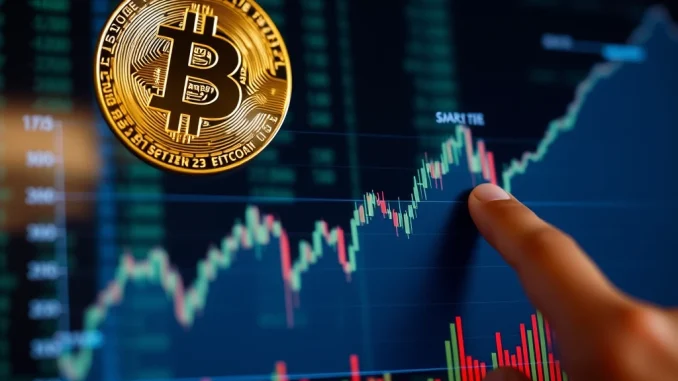
Are we nearing the top of the current Bitcoin rally? That’s the question on every crypto investor’s mind. While price charts grab headlines, looking under the hood at on-chain data provides crucial insights into market health. A recent observation from analyst Axel Adler Jr. sheds light on a key metric: the behavior of Bitcoin’s short-term holders (STHs).
Understanding Bitcoin STH SOPR and Profit Taking
Axel Adler Jr. highlighted on X that while Bitcoin STHs are indeed engaging in profit taking, this doesn’t necessarily mean the market is on the verge of a significant downturn or is currently ‘overheating’. This assessment relies heavily on specific on-chain indicators, particularly the Spent Output Profit Ratio (SOPR).
The SOPR metric is a powerful tool used in **market analysis**. It measures whether market participants are selling their coins at a profit or a loss. Specifically, the STH SOPR focuses only on coins moved by addresses that held them for less than 155 days. A value above 1 indicates that STHs are selling at a profit on average, while a value below 1 suggests they are selling at a loss. When the SOPR is exactly 1, it means assets are being sold at their cost basis.
According to the analyst, the 30-day moving average of the **BTC STH SOPR** has recently reached a local high. This confirms that a significant amount of recent selling activity from STHs has been at a profit. This is a natural part of any bull market cycle, as early buyers realize gains.
Is the Market Overheating? The STH SOPR Perspective
While profit taking is occurring, the crucial point raised by Adler Jr. is that the market has not yet reached ‘euphoric levels’ typically associated with major price peaks and subsequent corrections. How do analysts determine this using SOPR?
Historically, during major market tops (like in late 2017 or early 2021), the STH SOPR metric tends to spike to very high levels, often exceeding 2 or even 3 on its raw reading, and its moving averages also reach elevated zones. This signifies widespread, aggressive profit-taking as euphoria grips the market and participants rush to lock in gains at inflated prices.
The current reading, while showing profit-taking, is reportedly not yet at these historical peak levels. This suggests that while some distribution is happening among recent buyers, the intense, frothy selling indicative of a market top is not yet prevalent.
The Role of Robust Crypto Demand
Another critical factor supporting the analyst’s view is the continued strength in **crypto demand**. Even with STHs selling for profit, there appears to be sufficient buying pressure to absorb this supply without causing a significant price collapse. This robust demand can stem from various sources:
- New retail investors entering the market.
- Institutional interest, potentially through products like Bitcoin ETFs.
- Long-term holders accumulating during dips.
- Increased utility or adoption of Bitcoin and other cryptocurrencies.
Strong demand acts as a buffer against selling pressure. If demand is weak, even modest profit-taking can lead to sharp price declines. The current environment, as suggested by the analyst, indicates demand is keeping pace with or exceeding the supply being released by short-term holders.
Putting It Together: What Does This Analysis Mean?
The combination of moderate STH profit-taking (not yet at peak euphoria levels) and robust demand paints a picture of a market that is consolidating or experiencing healthy corrections rather than signaling an imminent crash. It suggests:
- The current rally still has room to run before reaching historical top indicators.
- Selling pressure from STHs is being absorbed by new or existing demand.
- The market structure remains relatively healthy compared to previous blow-off tops.
However, it’s crucial to remember that on-chain data is just one piece of the puzzle. Macroeconomic factors, regulatory news, and overall market sentiment also play significant roles. While the **STH SOPR** is a valuable tool, it shouldn’t be used in isolation for making investment decisions.
Actionable Insights for Investors
So, what can investors take away from this **market analysis**?
Consider these points:
- **Monitor On-Chain Data:** Keep an eye on metrics like SOPR, Puell Multiple, MVRV, and exchange flows. These provide deeper insights than just price action.
- **Understand Holder Behavior:** Recognize that STH profit-taking is normal. Distinguish between healthy distribution and panic selling or euphoric dumping.
- **Assess Demand:** Look for signs of continued buying interest, whether from retail or institutions.
- **Manage Risk:** Even if the market isn’t ‘overheated’ yet, volatility is inherent in crypto. Maintain a risk management strategy appropriate for your portfolio.
- **Avoid Euphoria:** The analyst notes we aren’t at euphoric levels yet, but stay grounded. Don’t let FOMO dictate your decisions as the market rises.
This analysis suggests that the current phase is characterized by healthy activity rather than the dangerous extremes seen at previous peaks. The fact that **profit taking** is occurring but demand remains strong is a positive sign for the sustainability of the current trend, at least in the near term.
Conclusion: A Nuanced View of Bitcoin’s Market Health
The message from analyst Axel Adler Jr., supported by the behavior of the **BTC STH SOPR** and observed **crypto demand**, offers a nuanced perspective. Yes, short-term holders are taking profits – a natural and expected behavior in a rising market. However, the intensity of this profit-taking, when viewed through the lens of historical SOPR peaks, does not yet signal an overheated market on the brink of collapse. The continued absorption of this supply by robust demand is a key factor supporting this view. While caution is always warranted in volatile markets, this on-chain insight suggests that the current **Bitcoin** market structure remains relatively healthy, potentially indicating further upside potential before reaching a major top.



